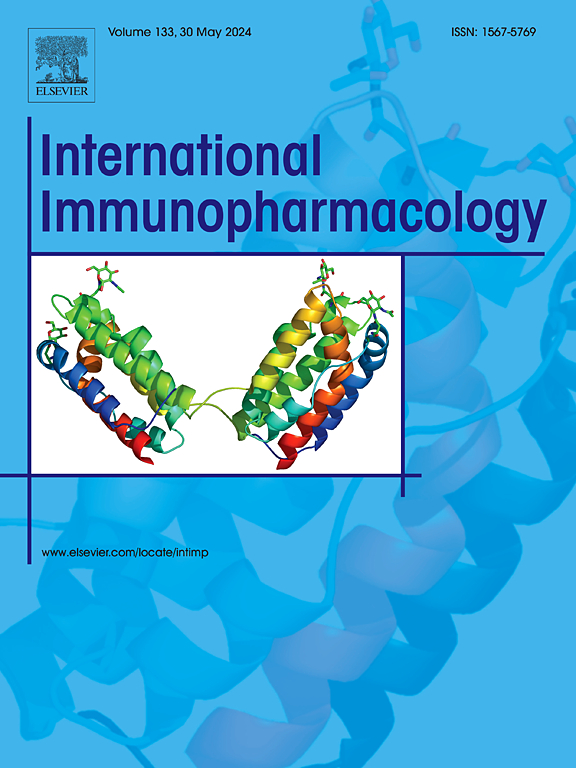揭示白细胞介素-12在神经炎症机制中的作用:将神经炎症与神经精神疾病联系起来的致病途径
IF 4.8
2区 医学
Q2 IMMUNOLOGY
引用次数: 0
摘要
神经精神疾病是一种具有临床特征的疾病,涉及神经病学和精神病学,由脑功能障碍或脑外疾病的间接影响引起。神经精神疾病倾向于影响情绪、情绪和大脑功能。越来越多的证据表明,这些疾病的病因不仅限于神经元异常,还包括炎症。虽然这些疾病的潜在机制仍处于起步阶段,但最近的数据强调了神经炎症在其病理生理中的重要作用。神经炎症涉及神经组织内的炎症,其特征是中枢神经系统内星形胶质细胞、细胞因子、小胶质细胞和趋化因子的改变。这些细胞因子包括IFN-γ、IL-1β、IL-2、il - 4、IL-6、IL-8、IL-10和IL-12。本文综述了白细胞介素-12 (IL-12),神经炎症的关键介质,及其在神经精神疾病中的潜在参与。IL-12促进神经炎症并影响神经递质系统。此外,它还影响HPA轴,损害神经可塑性,并通过与TLR、JAK-STAT、PI3K/Akt、GSK-3、NMDA、MAPK、PKC、VEGFR、ROCK和Wnt信号通路相互作用激活小胶质细胞,并引发其在ND中的作用。在这篇综述中,我们详述了目前支持IL-12致病作用的证据,并探讨了IL-12促进这些疾病发生和发展的可能机制。本综述旨在通过阐明神经炎症和神经精神疾病之间的相互作用,为未来的治疗策略提供见解。本文章由计算机程序翻译,如有差异,请以英文原文为准。
Unravelling the role of Interleukin-12 in Neuroinflammatory mechanisms: Pathogenic pathways linking Neuroinflammation to neuropsychiatric disorders
Neuropsychiatric disorders are clinically characterized conditions involving both neurology and psychiatry, arising from dysfunctioning of cerebral function, or indirect effects of extra cerebral disease. Neuropsychiatric disorders tend to influence emotions, mood, and brain functioning. Growing evidence indicates that the etiology of these disorders is not confined to neuronal abnormalities but extends to include inflammation. While the underlying mechanism of these disorders is still in its infancy, recent data highlights the significant role of neuroinflammation in their pathophysiology. Neuroinflammation concerns the inflammation within the neural tissue characterized by alteration in astrocytes, cytokines, microglia, and chemokines within the central nervous system. The cytokines include IFN-γ, IL-1β, IL-2, IL4, IL-6, IL-8, IL-10, and IL-12. This review focuses on interleukin-12 (IL-12), a key mediator of neuroinflammation, and its potential involvement in neuropsychiatric disorders. IL-12 promotes neuroinflammation and influences neurotransmitter systems. Additionally, it also affects the HPA axis, impairs neuroplasticity, and activates microglia by interacting with TLR, JAK-STAT, PI3K/Akt, GSK-3, NMDA, MAPK, PKC, VEGFR, ROCK, and Wnt signaling pathways and elicit its role in ND. In this review, we dwell on the current evidence supporting IL-12's pathogenic role and explore the possible mechanisms by which it contributes to the development and progression of these conditions. This review aims to provide insights that may aid in future therapeutic strategies by illuminating the interplay between neuroinflammation and neuropsychiatric disorders.
求助全文
通过发布文献求助,成功后即可免费获取论文全文。
去求助
来源期刊
CiteScore
8.40
自引率
3.60%
发文量
935
审稿时长
53 days
期刊介绍:
International Immunopharmacology is the primary vehicle for the publication of original research papers pertinent to the overlapping areas of immunology, pharmacology, cytokine biology, immunotherapy, immunopathology and immunotoxicology. Review articles that encompass these subjects are also welcome.
The subject material appropriate for submission includes:
• Clinical studies employing immunotherapy of any type including the use of: bacterial and chemical agents; thymic hormones, interferon, lymphokines, etc., in transplantation and diseases such as cancer, immunodeficiency, chronic infection and allergic, inflammatory or autoimmune disorders.
• Studies on the mechanisms of action of these agents for specific parameters of immune competence as well as the overall clinical state.
• Pre-clinical animal studies and in vitro studies on mechanisms of action with immunopotentiators, immunomodulators, immunoadjuvants and other pharmacological agents active on cells participating in immune or allergic responses.
• Pharmacological compounds, microbial products and toxicological agents that affect the lymphoid system, and their mechanisms of action.
• Agents that activate genes or modify transcription and translation within the immune response.
• Substances activated, generated, or released through immunologic or related pathways that are pharmacologically active.
• Production, function and regulation of cytokines and their receptors.
• Classical pharmacological studies on the effects of chemokines and bioactive factors released during immunological reactions.

 求助内容:
求助内容: 应助结果提醒方式:
应助结果提醒方式:


